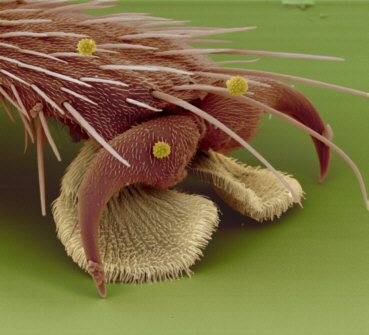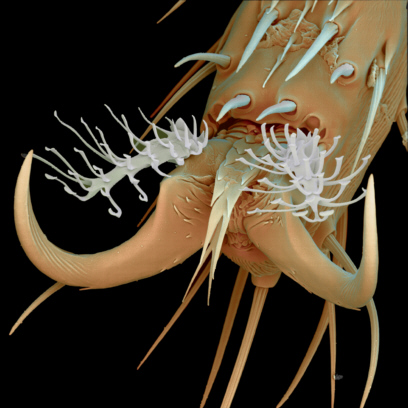published in: "TopoSonic Spheres - A Space-soundComposition"
booklet text of the CD/DVD publication by WERGO / artist.cd, September 2004
<sabine schäfer // joachim krebs>
TopoSonic Spheres
- A Space-soundComposition
I.
The Space-soundMaterials
(Sp-s-Materials)
Exclusively recordings of natural noises and sounds constitute the basic and source material of this Sp-s-Composition.
Three different basic types of Sp-s-Materials specific for this work are extracted from the underlying three basic categories of resources for material ”nature – animal – human” which are at the core of all the works by the two artists since 1998 – starting with the TopoSonic Mandala " AquaAngelusVox"
- Animal-Nature-Atmospheres (9 Sp-s-Milieux): Insects, amphibia, birds, apes - Air, water, rain forest and jungle, the landscape of marshes and moors, desert
- Voices of Insects (9 Sp-s-Milieux): Grasshoppers, crickets, flies, beetles
- Sounding Metal Objects (3 Sp-s-Milieux): Only noises created by humans with/on the most diverse metals by rolling, rubbing, whistling and squeaking.
In addition to the inner richness and lively variety of the ”found” and at first still amorphous-heterogeneous Sp-s basic material, the fact is of crucial importance that all the acoustic parameters such as rhythm, frequency, dynamics, spatiality and tone colour e.g. of the animal voices are marked by movements or activities such animals generate e.g. for the survival of the species, in their search for food or to mark their territory, or, as is the case for the natural sounds, by climatic conditions, the surrounding landscape or the vegetation.
Mainly because of the original process of optimised material exploitation through the microscopy of space and sound (which we call ”EndoSonoScopy”), this leads to an enormous increase, indeed, of ”new” (kinds of) basic and source material which can only be realised through the latest computer technology (sampling technique) and beyond the naturally subjectively limited human power of imagination.
Furthermore, it is the universal meanings and characters, aiming across all political-cultural borders of the sounds and noises of natural origin, known and familiar to everyone in their everyday life, which enable the listener to spontaneously access the actual Sp-s work of art – regardless of the underlying experimental-avantgarde approach – without certain cultural prerequisites, marks and knowledge.
II. The Space-soundMicroscopy (Sp-s-Microscopy) / EndoSonoScopy
If one were to transfer Paul Klee’s famous approach, phrased in 1920, and more scientific than artistic only at first glance, from the ”visual” to the ”auditory”, it would emerge as the following:
”(Sound) Art does not convey the visible (audible), but it makes visible (audible).”
If one, among other things, follows this maxim, one is faced with the question: How can one consolidate the material, the individual, still amorphous-heterogeneous Sp-s-Elements both mutual and reciprocal, with momentum and practically ”in itself” and ”in the other”, and intensify the naturally existent as well as the future artificially ”composable” capability of consistency by the Sp-s-Artist – always starting from the material, in order that the Sp-s-Components selected according to artistic criteria capture the invisible, inaudible - yes - unthinkable powers and energies beforehand, or generate and unfold them by themselves from their own middle, from the interior of the microdimensions of acoustic spaces, sounds and noises?”
The first important step towards an answer to this complex question represents itself in and through the acoustic process of transformation: the dissolution of the (non-)sonorous, only concrete matter of content and meaning, and from its conversion into a purely sonorous, not just abstract, ”desubjectivised expressive matter” (Deleuze/Guattari).2)
 By using digital sound processors (sampler) and computer-aided sampling techniques, this ”audio metamorphosis” can succeed especially with the following three productive processes:
By using digital sound processors (sampler) and computer-aided sampling techniques, this ”audio metamorphosis” can succeed especially with the following three productive processes:
- the Sp-s-Molecularisation which ”makes audible” what previously was ”inaudible” by acoustic space and sound microscopy followed by an analysis of acoustic-molecular internal structures
- the Sp-s-Fragmentation with ensuing artificial creation of self-intensifying loops (loops/warps) to externalise the own inner intensities.
- the Sp-s-Elementarisation with ensuing artificial consistency formation by creating temporary-specific mixes in the ”form” of individual Sp-s-Milieux.
The sound characteristics that have major importance particularly for the artificial consistency formation are often concealed from the bare ears, e.g. because they are beyond the human frequency audio barrier or because their rhythm sequence is too fast, i.e. they have an impulse density that is too high. In these cases, the procedure of Sp-s-Microscopy renders a valuable service to make that audible which was previously ”non-audible”, but already existing.
